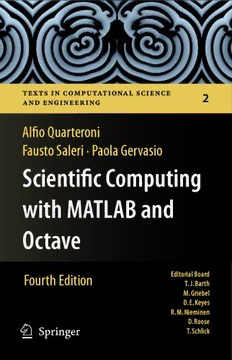
Scientific Computing with MATLAB and Octave PDF
Preview Scientific Computing with MATLAB and Octave
2 Alfi o Quarteroni Fausto Saleri · Paola Gervasio Scientifi c Computing with MATLAB and Octave Editorial Board Fourth Edition T. J.Barth M.Griebel D.E.Keyes R.M.Nieminen D.Roose 1 3 T.Schlick Texts in Computational 2 Science and Engineering Editors TimothyJ.Barth Michael Griebel David E. Keyes Risto M.Nieminen Dirk Roose TamarSchlick Forfurthervolumes: http://www.springer.com/series/5151 Alfio Quarteroni Fausto Saleri • • Paola Gervasio Scientific Computing with MATLAB and Octave Fourth Edition 123 AlfioQuarteroni FaustoSaleri(1965-2007) MATHICSE-CMCS MOX-PolitecnicodiMilano EcolePolytechniqueFe´de´rale Milano deLausanne Italy Lausanne Switzerland PaolaGervasio DICATAM Universita`degliStudidiBrescia Brescia Italy ISSN1611-0994 ISBN978-3-642-45366-3 ISBN978-3-642-45367-0(eBook) DOI10.1007/978-3-642-45367-0 SpringerHeidelbergNewYorkDordrechtLondon LibraryofCongressControlNumber:2014932425 MathematicsSubjectClassification(2010):65-01,68U01,68N15 c Springer-VerlagBerlinHeidelberg2003,2006,2010,2014 ⃝ Thisworkissubjecttocopyright.AllrightsarereservedbythePublisher,whetherthewholeor partofthematerialisconcerned,specifically therightsoftranslation, reprinting, reuseofillus- trations, recitation, broadcasting, reproduction onmicrofilmsorinanyother physical way,and transmissionorinformationstorageandretrieval,electronicadaptation,computersoftware,orby similarordissimilarmethodologynowknownorhereafterdeveloped.Exemptedfromthislegal reservationarebriefexcerptsinconnectionwithreviewsorscholarlyanalysisormaterialsupplied specifically forthepurposeofbeingenteredandexecuted onacomputer system,forexclusive usebythepurchaserofthework.Duplicationofthispublicationorpartsthereofispermittedonly undertheprovisionsoftheCopyrightLawofthePublisher’slocation,initscurrentversion,and permissionforusemustalwaysbeobtainedfromSpringer.Permissionsforusemaybeobtained throughRightsLinkattheCopyrightClearanceCenter.Violationsareliabletoprosecutionunder therespectiveCopyrightLaw. Theuseofgeneral descriptive names, registered names,trademarks, service marks,etc. inthis publicationdoesnotimply,evenintheabsenceofaspecificstatement,thatsuchnamesareexempt fromtherelevantprotectivelawsandregulationsandthereforefreeforgeneraluse. Whiletheadviceandinformationinthisbookarebelievedtobetrueandaccurateatthedateof publication,neithertheauthorsnortheeditorsnorthepublishercanacceptanylegalresponsibility foranyerrorsoromissionsthatmaybemade.Thepublishermakesnowarranty,expressorim- plied,withrespecttothematerialcontainedherein. Thepictureonthecovershowsare-entrantelectricalwaveonaslabofhomogeneousexcitable medium, exhibiting spiral turbulence andspatiotemporal chaos. Computation byRicardo Ruiz- Baier,IST,UniversityofLausanne,CH. Printedonacid-freepaper SpringerispartofSpringerScience+BusinessMedia(www.springer.com) To the memory of Fausto Saleri Preface Preface to the First Edition This textbook is an introduction to Scientific Computing. We will illustrate several numerical methods for the computer solution of cer- tain classes of mathematical problems that cannot be faced by paper and pencil. We will show how to compute the zeros or the integrals of continuous functions, solve linear systems, approximate functions by polynomials and construct accurate approximations for the solution of differential equations. With this aim, in Chapter 1 we will illustrate the rules of the game thatcomputersadoptwhenstoringandoperatingwithrealandcomplex numbers, vectors and matrices. In order to make our presentation concrete and appealing we will adopt the programming environment MATLAB! 1 as a faithful com- panion. We will gradually discover its principal commands, statements and constructs. We will show how to execute all the algorithms that we introduce throughout the book. This will enable us to furnish an im- mediate quantitative assessment of their theoretical properties such as stability, accuracy and complexity. We will solve several problems that willbe raisedthroughexercisesandexamples,oftenstemmingfromspe- cific applications. Severalgraphicaldeviceswillbeadoptedinordertorendertheread- ingmorepleasant.WewillreportinthemargintheMATLABcommand along side the line where that command is being introducedfor the first time. The symbol will be used to indicate the presence of exercises, the symbol to indicate the presence of a MATLAB program, while 1 MATLAB is a trademark of TheMathWorks Inc., 24 Prime Park Way, Natick, MA 01760, Tel: 001+508-647-7000, Fax: 001+508-647-7001. VII VIII Preface the symbol will be used when we want to attract the attention of the reader on a critical or surprising behavior of an algorithm or a pro- cedure.Themathematicalformulaeofspecialrelevanceareputwithina frame. Finally, the symbol indicates the presence of a display panel summarizing concepts and conclusions which have just been reported and drawn. Attheendofeachchapteraspecificsectionisdevotedtomentioning those subjects which have not been addressed and indicate the biblio- graphicalreferencesforamore comprehensivetreatmentofthe material that we have carried out. Quite often we will refer to the textbook [QSS07] where many issues facedinthisbookaretreatedatadeeperlevel,andwheretheoreticalre- sults areproven.ForamorethoroughdescriptionofMATLABwerefer to [HH05]. All the programs introduced in this text can be downloaded from the web address mox.polimi.it/qs Nospecialprerequisiteisdemandedofthereader,withtheexception of an elementary course of Calculus. However,inthe courseofthe firstchapter,we recallthe principalre- sultsofCalculusandGeometrythatwillbeusedextensivelythroughout this text. The less elementary subjects, those which are not so neces- saryforanintroductoryeducationalpath,arehighlightedbythespecial symbol . We express our thanks to Thanh-Ha Le Thi from Springer-Verlag Heidelberg,andtoFrancescaBonadeiandMarinaForlizzifromSpringer- Italia for their friendly collaborationthroughout this project. We grate- fully thank Prof.EasthamofCardiff Universityfor editing the language ofthewholemanuscriptandstimulatingustoclarifymanypointsofour text. Milano and Lausanne Alfio Quarteroni May 2003 Fausto Saleri Preface to the Second Edition In this second edition we have enriched all the Chapters by intro- ducing several new problems. Moreover, we have added new methods for the numerical solution of linear and nonlinear systems, the eigen- value computation and the solution of initial-value problems. Another relevant improvement is that we also use the Octave programming en- vironment. Octave is a reimplementation of part of MATLAB which Preface IX includesmanynumericalfacilitiesofMATLABandisfreelydistributed under the GNU General Public License. Throughout the book, we shall often make use of the expression “MATLAB command”: in this case, MATLAB should be understood as the language which is the common subset of both programs MAT- LAB and Octave. We have striven to ensure a seamless usage of our codesandprogramsunderbothMATLABandOctave.Inthefewcases where this does not apply, we shall write a short explanation notice at the end of each corresponding section. For this secondeditionwe wouldlike to thank PaolaCausinfor hav- ingproposedseveralproblems,ChristophePrud´homme,JohnW.Eaton and David Bateman for their help with Octave, and Silvia Quarteroni for the translation of the new sections. Finally, we kindly acknowledge the supportofthe Poseidonprojectofthe EcolePolytechniqueF´ed´erale de Lausanne. Lausanne and Milano Alfio Quarteroni May 2006 Fausto Saleri Preface to the Third Edition Thisthirdeditionfeaturesacompleterevisitationofthewholebook, many improvementsin styleandcontentto all the chapters,aswell asa substantial newdevelopmentofthosechaptersdevotedto the numerical approximation of boundary-value problems and initial-boundary-value problems. We remind the reader that all the programs introduced in this text can be downloaded from the web address mox.polimi.it/qs Lausanne, Milano and Brescia Alfio Quarteroni March 2010 Paola Gervasio Preface to the Fourth Edition The fourth edition features the addition of a new chapter on numeri- cal optimization of both univariate and multivariate functions in which several methods are presented, discussed and analyzed. Forunconstrainedminimization,weconsiderderivativefreemethods, descent (or line search) methods, and trust region methods. For constrained minimization we restrict our discussion to penaliza- tion methods and augmented Lagrangianmethods.
